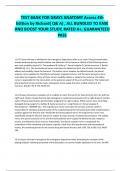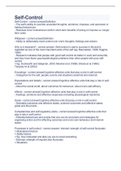TEST BANK FOR GRAYS ANATOMY Access 4th
Edition by Richard( Q& A) , ALL BUNDLED TO EASE
AND BOOST YOUR STUDY, RATED A+, GUARANTEED
PASS
11 A 27-year-old man is admitted to the emergency department after a car crash. Physical examination
reveals weakness during medial rotation and adduction of the humerus. Which of the following nerves
was most probably injured? A. Thoracodorsal B. Axillary C. Dorsal scapular D. Spinal accessory E. Radial -
ANSWER @ 11 A. The thoracodorsal nerve innervates the latissimus dorsi, one of major muscles that
adduct and medially rotate the humerus. The axillary nerve supplies the deltoid muscle, the dorsal
scapular nerve supplies the rhomboids and levator scapulae muscles, and the spinal accessory nerve
innervates the trapezius. None of these nerves medially rotates or adducts the humerus. The radial
nerve is responsible for the innervation on the posterior aspect of the arm and forearm. The medial and
lateral pectoral nerves and the lower subscapular nerve supply the other medial rotators of the
humerus. GAS 87, 99; N 174; McM 101
12 A 39-year-old woman complains of an inability to reach the top of her head to brush her hair with her
right hand. History reveals that she had undergone a mastectomy procedure of her right breast 2 months
earlier. Physical examination demonstrates winging of her right scapula. Which nerves were most likely
damaged during surgery? A. Axillary B. Spinal accessory C. Long thoracic D. Dorsal scapular E.
Thoracodorsal - ANSWER 12 C. The long thoracic nerve innervates the serratus anterior, which is
responsible for elevation and protraction of the scapula beyond the horizontal level while maintaining its
position against the thoracic wall. Along with the thoracodorsal nerve, the long thoracic nerve runs
superficially along the thoracic wall and is subject to injury during a mastectomy procedure. The axillary
nerve, the spinal accessory nerve, and the thoracodorsal nerve supply the deltoid muscle, trapezius
muscle, and latissimus dorsi muscles, respectively. The dorsal scapular nerve is responsible for
innervation of the rhomboids and levator scapulae. Aside from the long thoracic and thoracodorsal
nerves, the remaining nerves do not course along the lateral thoracic wall. GAS 726; N 180, 413; McM
140
13 A 19-year-old man is brought to the emergency department after dislocating his shoulder while
playing football. Following treatment of the dislocation, he cannot initiate abduction of his arm. An MRI
,of the affected shoulder shows a torn muscle. Which muscle was most likely damaged by the injury? A.
Coracobrachialis B. Long head of the triceps brachii C. Pectoralis minor D. Supraspinatus E. Teres major -
ANSWER 13 D. The rotator cuff muscles are common sites of damage during shoulder injuries. These
muscles include the supraspinatus, infraspinatus, teres minor, and subscapularis (SITS). Initiation of
abduction of the humerus (the first 15 degrees) is performed by the supraspinatus, followed by the
deltoid from 15 to 90 degrees. Above the horizontal, the scapula is rotated by the trapezius and serratus
anterior muscles, causing the glenoid fossa to turn superiorly and allowing the humerus to move above
90 degrees. The teres major and the pectoralis major are responsible for medial rotation and adduction
of the humerus. These muscles are therefore not involved in abduction at the glenohumeral joint. GAS
711-712, 717; N 134-135; McM 411, 413
14 A 1-year-old girl is brought to the clinic for a routine checkup. The child appears normal except for a
dimpling of the skin in the midline of the lumbar region with a tuft of hair growing over the dimple.
What is this relatively common condition that results from incomplete embryologic development? A.
Meningomyelocele B. Meningocele C. Spina bifida occulta D. Spina bifida cystica E. Rachischisis -
ANSWER 14 C. Spina bifida is a developmental condition resulting from incomplete fusion of the
vertebral arches within the lumbar region. Spina bifida occulta commonly presents asymptomatically
with midline, lumbar, cutaneous stigmata such as a tuft of hair and a small dimple. More severe forms
(spina bifida cystica) are categorized into three types: Spina bifida cystica with meningocele presents
with protrusion of the meninges through the unfused vertebral arches; spina bifida with
myelomeningocele is characterized by protrusion both of the meninges and central nervous system
(CNS) tissues and is often associated with neurologic deficits; and rachischisis, also known as spina bifida
cystica with myeloschisis, results from a failure of neural folds to fuse and is characterized by protrusion
of the spinal cord or spinal nerves and meninges. GAS 74; N 14, 160; McM 77, 88
15 A young resident complains of an itch on his back that appears to be caused by an insect bite. Which
nerve fibers carry the sensation of a mosquito bite on the back, just lateral to the spinous process of the
T4 vertebra? A. Somatic afferent B. Somatic efferent C. Visceral afferent D. Visceral efferent E. Somatic
efferent and visceral afferent - ANSWER 15 A. Somatic afferents are responsible for conveying pain,
pressure, touch, temperature, and proprioception to the CNS. Afferent fibers carry only sensory stimuli,
whereas efferent fibers convey motor information. Visceral innervation is associated with the autonomic
nervous system. Visceral afferents generally carry information regarding the physiologic changes of the
internal viscera whereas visceral efferents deliver autonomic motor function to three types of tissue:
smooth muscle, cardiac muscle, and glandular epithelium. GAS 32-35; N 174; McM 211
16 A 15-year-old woman was suspected of having meningitis. To obtain a sample of cerebrospinal fluid
by spinal tap in the lumbar region (lumbar puncture), the tip of the needle must be placed in which of
the following locations? A. In the epidural space B. Between anterior and posterior longitudinal
ligaments C. Superficial to the ligamentum flavum D. Between arachnoid mater and dura mater E. In the
subarachnoid space - ANSWER 16 E. CSF is found within the subarachnoid space and is continuous with
the ventricles of the brain (CSF flows from the ventricles to the subarachnoid space). The epidural space,
,positioned between the dura mater and periosteum, contains fat and the internal vertebral venous
plexus (of Batson). The subdural space, between the arachnoid mater and dura mater, exists only as a
potential space and does not contain cerebrospinal fluid. The anterior and posterior longitudinal
ligaments traverse the length of the vertebral bodies. GAS 106, 114-116; N 166; McM 97
17. A 19-year-old man is diagnosed with a herniated disc but he has no symptoms of spinal cord injury. In
the event of intervertebral disc herniation in the cervical region, which of the following ligaments is in an
anatomic position to protect the spinal cord from direct compression? A. Supraspinous B. Posterior
longitudinal C. Anterior longitudinal D. Ligamentum flavum E. Nuchal ligament - ANSWER 17 B. The
posterior longitudinal ligament is the only ligament spanning the posterior aspect of the vertebral bodies
and intervertebral discs. With inter vertebral disc herniation, the nucleus pulposus of the intervertebral
disc protrudes posterolaterally. The anterior longitudinal ligament traverses the anterior side of the
vertebral bodies and thus would not protect the spinal cord from direct compression. The supraspinous
and ligamentum flavum ligaments connect the spinous processes and the laminae of adjacent vertebrae,
respectively. The nuchal ligament is a continuation of the supraspinous ligaments near the C7 vertebrae
and runs to the occipital protuberance. GAS 80-81; N 159; McM 94
18 In spinal anesthesia, the needle is often inserted between the spinous processes of the L4 and L5
vertebrae to ensure that the spinal cord is not injured. This level is safe because in the adult the spinal
cord usually terminates at the disc between which of the following vertebral levels? A. T11 and T12 B.
T12 and L1 C. L1 and L2 D. L2 and L3 E. L3 and L4 - ANSWER 18 C. This is the location of the conus
medullaris, a tapered conical projection of the spinal cord at its inferior termination. Although the conus
medullaris rests at the level of L1 and L2 in adults, it is often situated at L3 in newborns. The cauda
equina and filum terminale extend beyond the conus medullaris. GAS 99, 100; N 161; McM 97
19 A 22-year-old woman is diagnosed with Raynaud's disease. In such a case, the patient suffers chronic
vasospasm in response to cold. This can lead to arterial constriction and painful ischemia, especially in
the fingers or toes. Relief from the symptoms in the hands would require surgical division of which of the
following neural elements? A. Lower cervical and upper thoracic sympathetic fibers B. Lower cervical and
upper thoracic ventral roots C. Lower cervical and upper thoracic dorsal roots D. Lower cervical and
upper thoracic spinal nerves E. Bilateral spinal accessory nerves - ANSWER 19 A. The sympathetic
division of the autonomic nervous system is primarily responsible for vasoconstriction. Separation of
ventral or dorsal roots would lead to undesired consequences, such as a loss of motor or sensory activity.
Similarly, surgical division of spinal nerves would also have unwanted consequences, but such are not
related to the increased arterial constriction and the painful ischemia in the digits. Division of selected
sympathetic chain ganglia, however, would decrease the sympathetic outflow to the upper limbs. GAS
38-39; N 163; McM 94-95
20 A 69-year-old woman visits her physician due to severe neck pain. Radiologic studies reveal bony
growths (osteophytes) in the intervertebral foramen between vertebrae C2 and C3. Which of the
, following muscles would be most likely affected by this condition? A. Rhomboideus major B. Serratus
anterior C. Supraspinatus D. Diaphragm E. Latissimus dorsi - ANSWER 20 D. The diaphragm is innervated
by the phrenic nerve, which arises from C3 to C5. The rhomboid, serratus anterior, supraspinatus, and
latissimus dorsi are innervated by the ventral rami of the brachial plexus (C5 to T1). GAS 161-162; N 161;
McM 194
21 A 42-year-old woman is diagnosed with stenosis of the cervical vertebral canal. A laminectomy of two
vertebrae is performed. Which of the following ligaments will most likely also be removed? A. Anterior
longitudinal B. Denticulate C. Ligamentum flavum D. Nuchal E. Cruciate - ANSWER 21 C. The anterior
longitudinal ligament runs along the anterior-most aspect of the vertebral column from C1 to the sacrum
and would therefore be unaffected by a laminectomy. Denticulate ligaments extend laterally from the pia
mater to the arachnoid mater along the length of the spinal cord. The ligamentum flavum is one of the
two ligaments found in the vertebral canal and is adherent to the anterior aspect of the vertebral arches
and often greatly thickened in spinal pathology. It is thus simultaneously removed upon excision of the
lamina. The nuchal ligament is a thick longitudinal extension continuing from the supraspinous ligament
at the level of C7 to the external occipital protuberance (inion). The cruciate ligament is an incorrect
answer because it is located anterior to the spinal cord, and thus would not be involved in laminectomy.
GAS 80; N 159; McM 98
22 A 28-year-old pregnant woman is admitted to the obstetrics department for delivery. In the final
stages of labor, a caudal anesthetic is administered via the sacral hiatus. Into which of the following
spaces in the sacral canal is the anesthetic placed? A. Vertebral canal B. Vertebral venous plexus C.
Epidural space D. Subarachnoid space E. Subdural space - ANSWER 22 C. The vertebral canal is the
longitudinal canal that extends through the vertebrae, containing the meninges, spinal cord, and
associated ligaments. The internal vertebral venous plexus is the mostly valveless network of veins
extending longitudinally along the vertebral canal. Neither of these answer choices describes a specific
space. The spinal epidural space is found superficially to the dura mater. It is a fat-filled space extending
from C1 to the sacrum. The subarachnoid space is a true space containing CSF. It is found within the CNS
and extends to the level of S2. The subdural space is a potential space between the dura and the
arachnoid mater. Normally, these two layers are fused due to the pressure of CSF in the subarachnoid
space. GAS 103-110; N 166; McM 94, 96
23 A 12-year-old child was brought to the emergency department by his parents because he has been
suffering from a very high fever and severe stiffness in his back. The initial diagnosis is meningitis. The
attending physician orders a lumbar puncture to confirm the diagnosis. Upon microscopic examination of
the cerebrospinal fluid, hematopoietic cells are seen. Which of the following ligaments was most likely
penetrated by the needle? A. Supraspinous B. Denticulate C. Anterior longitudinal D. Posterior
longitudinal E. Nuchal ligament - ANSWER 23 A. Lumbar puncture is generally performed at the level of
L4 or L5. The supraspinous ligament extends between spinous processes on the dorsal aspect of the
vertebrae. The needle will bypass this structure. The denticulate ligaments are not correct because they
terminate with the conus medullaris at the level of L2 and are located laterally. The anterior longitudinal






